
Anatomical Sciences Education
Scope & Guideline
Pioneering the Future of Anatomical Education
Introduction
Aims and Scopes
- Innovative Teaching Methods:
The journal emphasizes the development and evaluation of innovative teaching methods in anatomy education, including active learning strategies, flipped classrooms, and the integration of technology such as virtual and augmented reality. - Ethical Considerations in Anatomy Education:
A significant focus is placed on ethical issues related to body donation, dissection practices, and the respectful treatment of anatomical donors, reflecting the journal's commitment to fostering ethical standards within the educational framework. - Technological Integration:
The use of advanced technologies, including 3D printing, virtual reality, and artificial intelligence, is a recurring theme, highlighting how these tools can enhance the learning experience and improve educational outcomes in anatomy. - Curricular Development and Assessment:
The journal explores the design, implementation, and assessment of anatomy curricula across various educational settings, addressing the challenges and opportunities presented by different pedagogical approaches. - Cultural and Contextual Relevance:
Research published in the journal often considers the cultural and contextual factors that influence anatomy education, including perspectives from diverse populations and the implications for teaching practices. - Interprofessional Collaboration:
There is a growing interest in the role of interprofessional education in anatomy, with studies examining collaborative approaches that enhance learning outcomes for students across different health professions.
Trending and Emerging
- Integration of Technology in Education:
There is a significant uptick in studies exploring the efficacy of technologies such as virtual reality, augmented reality, and artificial intelligence in enhancing anatomy learning experiences, highlighting the journal's embrace of modern educational tools. - Mental and Emotional Preparedness:
Emerging research focuses on the mental and emotional aspects of anatomy education, particularly regarding students' preparedness for dissection and their reflections on the experience, indicating a growing recognition of the psychological dimensions of learning anatomy. - Culturally Responsive Teaching:
An increasing emphasis on culturally responsive pedagogy in anatomy education is evident, with studies exploring how cultural considerations shape the learning experience and influence students' engagement with the subject. - Interdisciplinary Approaches:
There is a trend toward interdisciplinary research that combines anatomy education with other fields such as ethics, technology, and public health, fostering a more holistic understanding of the subject. - Focus on Inclusivity and Diversity:
The journal is witnessing a rise in discussions around inclusivity in anatomy education, addressing representation gaps and advocating for diverse perspectives in teaching and learning practices.
Declining or Waning
- Traditional Dissection Practices:
The reliance on traditional cadaver dissection is decreasing, with a shift towards alternative methods such as virtual dissections and digital simulations, reflected in the reduced frequency of studies focused solely on dissection. - Eponymous Terminology:
The usage of eponyms in anatomy education is becoming less favored as educators strive for clarity and inclusivity in anatomical terminology, leading to fewer papers addressing this topic. - Static Learning Environments:
Research on static, lecture-based learning environments is declining as there is a stronger emphasis on active, participatory learning strategies that engage students more effectively. - Focus on Basic Anatomy Without Contextual Application:
The emphasis on basic anatomical knowledge without integrating clinical or practical applications is diminishing, as the journal increasingly promotes studies that connect anatomy education to clinical practice and real-world scenarios. - Homogeneous Curriculum Models:
There is a noticeable decline in research advocating for one-size-fits-all curriculum models, with a growing preference for tailored approaches that consider diverse learner needs and educational contexts.
Similar Journals
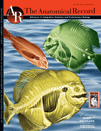
Anatomical Record-Advances in Integrative Anatomy and Evolutionary Biology
Connecting the Dots Between Anatomy and Evolution.Anatomical Record-Advances in Integrative Anatomy and Evolutionary Biology, an esteemed journal published by WILEY, serves as a pivotal platform for scholars in the fields of anatomy, biotechnology, ecology, evolutionary biology, and histology. With an ISSN of 1932-8486 and an E-ISSN of 1932-8494, this journal has demonstrated its academic rigor by maintaining a Q2 ranking across multiple relevant categories, including Anatomy and Biotechnology, and consistently achieving a high Scopus ranking in its respective fields. Its scope, covering integrative approaches to anatomical research and evolutionary studies, fosters interdisciplinary collaboration and innovation. Researchers and practitioners can access the journal through various open-access options, ensuring that groundbreaking findings are disseminated widely. As a vital resource for advancing knowledge and exploring emerging trends, this journal greatly contributes to the understanding of biological systems and evolutionary processes, making it an essential read for those dedicated to pushing the boundaries of their respective disciplines.
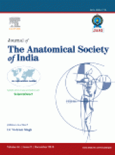
Journal of the Anatomical Society of India
Shaping the future of anatomical education and research.The Journal of the Anatomical Society of India, established in 1960, is a key publication in the field of anatomy and pathology, published by Wolters Kluwer Medknow Publications. With an ISSN of 0003-2778 and an E-ISSN of 2352-3050, this journal serves as a vital platform for disseminating innovative research and advancements in anatomical sciences. Although it currently features a Q4 ranking in both the categories of Anatomy and Pathology and Forensic Medicine as of 2023, the journal aims to elevate scientific discussions and collaborations among researchers, professionals, and students. The impact factor highlights its relevance in the scientific community, although specific metrics are currently unavailable. Located in the dynamic hub of Mumbai, India, the journal encapsulates a commitment to enriching academic discourse while addressing the latest developments and breakthroughs in the field. Researchers looking for a valued resource within anatomy and related disciplines will find this journal an essential read.

Contemporary Educational Technology
Connecting Research and Practice in Educational TechnologyContemporary Educational Technology is a premier journal published by BASTAS PUBL LTD - UK, specializing in the dynamic intersection of educational practices and technological advancements. With an E-ISSN of 1309-517X, this journal serves as a vital resource for researchers, educators, and professionals keen to explore innovative solutions and methodologies in education. Ranked in the Q2 category for both Education and Management of Technology and Innovation in 2023, Contemporary Educational Technology boasts impressive Scopus ranks, standing at #187 out of 1543 in the Social Sciences Education field, reflecting its influence and contribution to contemporary research. Through its open-access approach, this journal facilitates the dissemination of knowledge, making cutting-edge research readily available to a global audience. By examining developments from 2018 through 2024, it aims to critically analyze and promote the integration of technology in educational contexts, thereby fostering improved learning outcomes and innovative teaching practices.

Bulletin of the Technical Committee on Learning Technology
Connecting Research and Practice in Learning TechnologiesBulletin of the Technical Committee on Learning Technology, published by IEEE-INST ELECTRICAL ELECTRONICS ENGINEERS INC, is a pivotal journal that intersects the realms of education and computer science. With a noteworthy ISSN of 2306-0212, this journal serves as a vital platform for disseminating innovative research and development in learning technologies, particularly focusing on technological advancements that enhance educational environments and methodologies. Although coverage in Scopus has been discontinued, the journal's past contributions are reflected in its competitive rankings, with a position of Rank #624 in Social Sciences - Education and Rank #427 in Computer Science - Computer Science Applications. This indicates a solid niche in the academic landscape, making it a valuable resource for researchers, educators, and practitioners seeking to advance the dialogue around technology integration in learning. The Bulletin fosters an open exchange of knowledge and encourages the exploration of emerging technology applications in education, positioning itself as an important component in the ongoing development of learning technologies.
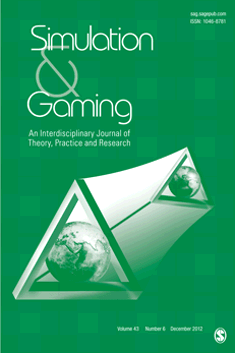
SIMULATION & GAMING
Unleashing the Power of Simulation for Real-World ImpactSIMULATION & GAMING, published by SAGE PUBLICATIONS INC, is a leading academic journal that explores the intersection of simulation and gaming within diverse fields such as business, social sciences, and computer science. With an ISSN of 1046-8781 and an E-ISSN of 1552-826X, this journal stands out in its commitment to advancing knowledge through high-quality research and innovative methodologies. As a testament to its influence, it is ranked Q1 in Social Sciences and Q2 in both Business, Management and Accounting, and Computer Science Applications, indicating its reputable position among scholars. Researchers, educators, and professionals will find valuable insights into the applications and implications of simulation and gaming, making it an essential resource for cutting-edge developments in these rapidly evolving domains. Access to its comprehensive archives allows for exploration of pivotal studies dating back to 1970, supporting the ongoing dialogue in this interdisciplinary area of research.
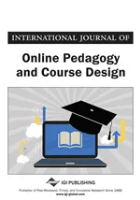
International Journal of Online Pedagogy and Course Design
Connecting theory and practice in online pedagogy.The International Journal of Online Pedagogy and Course Design, published by IGI Global, serves as a vital resource for researchers, educators, and practitioners interested in the integration of technology in education. Since its inception in 2017, this journal has focused on the latest advancements in online teaching methodologies, course design, and assessment frameworks, contributing to the dynamic field of educational technology. It is indexed in Scopus and currently ranks Q4 in the Education category, reflecting its growing influence within the academic community. The journal provides an invaluable platform for sharing innovative research and practical insights that enhance online learning experiences, crucial in today’s digitally-driven educational landscape. With an ISSN of 2155-6873 and E-ISSN of 2155-6881, the journal is dedicated to fostering a collaborative environment where ideas and practices in online pedagogy can thrive.

International Journal of Instruction
Illuminating the path to effective instructional strategies.International Journal of Instruction is a distinguished peer-reviewed journal dedicated to advancing the field of education through high-quality research and innovative instructional practices. Published by GATE Association for Teaching & Education in Switzerland, this open-access journal has been a beacon of knowledge since its inception in 2008, ensuring that impactful educational research is freely accessible to scholars, educators, and practitioners worldwide. With an impressive Q2 ranking in Education and a notable position in the 80th percentile within its category in Scopus, the journal showcases cutting-edge studies and discussions that reflect current trends and methodologies in teaching and learning. The scope of the journal includes a wide array of topics, ranging from instructional strategies to curriculum development, making it a vital resource for anyone engaged in the dynamic landscape of education. Explore the International Journal of Instruction today to contribute to and benefit from the collective wisdom of the global educational community.
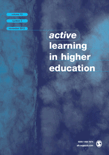
Active Learning in Higher Education
Fostering Engagement and Excellence in Higher EducationActive Learning in Higher Education is a premier journal dedicated to exploring innovative and effective pedagogical practices within the realm of higher education. Published by SAGE Publications Inc, this journal boasts an impressive Q1 ranking in the Education category for 2023, positioning it within the top percentile of academic journals in the field, with a Scopus rank of 21 out of 1543, reflecting its high impact and relevance. With coverage spanning from 2000 to 2024, the journal serves as a critical platform for researchers, educators, and students, providing insightful articles that delve into the theories, strategies, and technologies that enhance active learning experiences. While currently not open access, the enriching content is vital for anyone aiming to stay abreast of evolving methodologies and empirical studies in educational practices. Located in the United Kingdom, this journal is committed to advancing the academic discourse surrounding higher education, making it essential reading for those interested in fostering student engagement and learning outcomes.

Informatics in Education
Bridging Technology and Pedagogy for Tomorrow's EducatorsInformatics in Education is a premier academic journal published by Vilnius University, Institute of Mathematics and Informatics, focusing on the intersection of information technology and pedagogical innovation. With an ISSN of 1648-5831 and an E-ISSN of 2335-8971, this Open Access journal has been disseminating critical research since 2003, enabling widespread accessibility and collaboration across the global educational community. The journal's commitment to advancing the field is demonstrated by its impressive 2023 Category Quartiles: Q1 in Communication and Education and Q2 in Computer Science Applications, highlighting its significant impact on these disciplines. Located in Lithuania, Informatics in Education ranks impressively in Scopus, with a Social Sciences Communication rank of #54/511 (89th percentile) and a Social Sciences Education rank of #188/1543 (87th percentile). The journal's goals include fostering research that informs pedagogical practices and enhances educational outcomes through the innovative use of technology, ensuring it remains at the forefront of research in this vital field. Researchers, professionals, and students alike will find a wealth of knowledge within its pages to support their work and learning endeavors.

JOURNAL OF DENTAL EDUCATION
Shaping Tomorrow's Dental ProfessionalsWelcome to the JOURNAL OF DENTAL EDUCATION, a leading peer-reviewed publication in the fields of dentistry and education, published by Wiley. Established in 1946, this journal remains at the forefront of dental education research, providing critical insights and advancements that shape the future of dental practice and academia. With an impressive impact factor and a ranking in the Q2 quartile for Dentistry, Education, and Medicine, it stands as a vital resource for professionals, educators, and students alike. The journal encompasses a wide array of topics, including innovative teaching methodologies, curriculum development, and evidence-based practice in dental education. Although it does not offer open access, the journal's content is accessible through various academic databases, ensuring researchers can stay informed on the latest trends and findings. As it continues to evolve, the JOURNAL OF DENTAL EDUCATION remains committed to fostering excellence in dental education and contributes significantly to the academic discourse in this essential field.